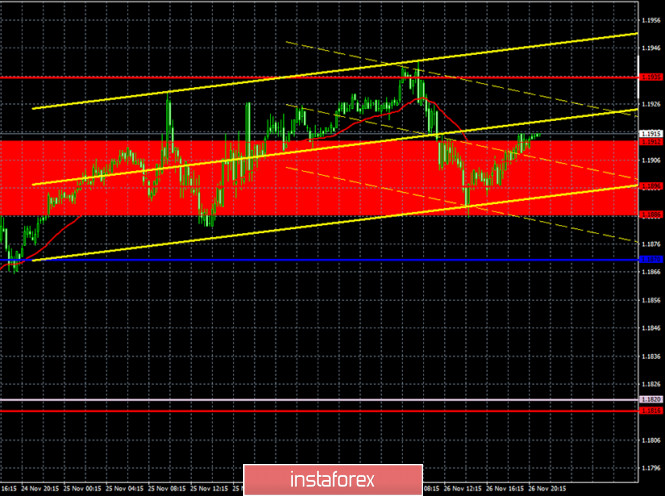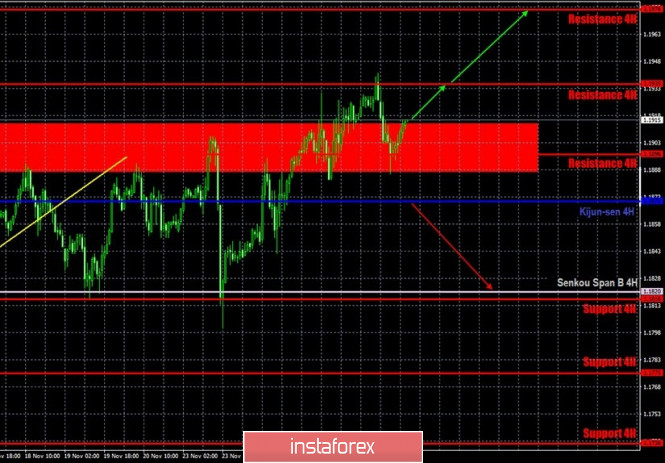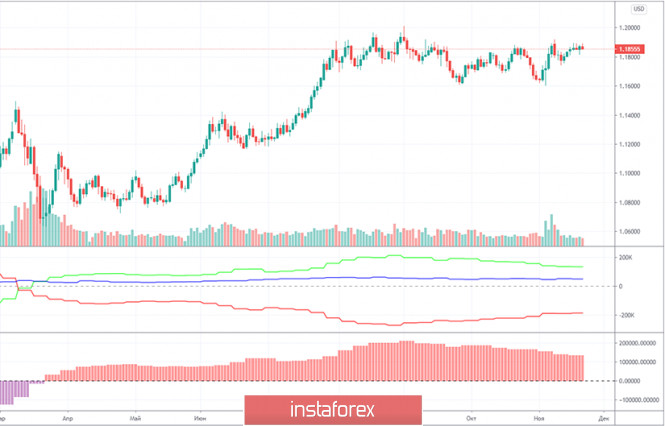EUR/USD 15M

The linear regression channels turned to the downside on the 15-minute timeframe, after it failed to overcome the 1.1935 level. We can clearly see a rebound from this level. The most interesting thing is that growth prospects remain unchanged and do not even decrease. The pair updates the previous day's high by 5-10 points every day. At this rate, the price will creep to the 1.2000 level for about another month.
EUR/USD 1H

The EUR/USD pair was still trading incomprehensibly with mind-blowing volatility on the hourly timeframe on Thursday, November 26. The pair managed to gain 56 points, which is still quite a good result. As for the movements, the pair was still able to overcome the resistance area of 1.1886-1.1912, which seems to increase the likelihood of sustaining growth. However, the first obstacle was the resistance level of 1.1935 - which pushed traders down to the 1.1886 level. Therefore, the EUR/USD pair has formally left the four-month horizontal channel. The upward trend may formally begin now. In fact, does anyone see the beginning of this very upward trend? At the moment, the quotes are five points higher than the area in which they spent most of the last four months. Therefore, it is absolutely impossible to predict where the pair will move in the coming days. The picture becomes even more confusing if we also add fundamental analysis here, since it is completely incomprehensible what exactly market participants are paying attention to at the moment. Judging by the nature of the movements, whatever is present.
COT report

The EUR/USD pair increased by 40 points in the last reporting week (November 10-16). As you can see, price changes are still minimal. There were certain bursts of activity during the US presidential elections, but they ended very quickly and now the pair is just trading in a horizontal channel, with minimal volatility. Therefore, we expect clarification of the current situation from the Commitment of Traders (COT) reports. Unfortunately, COT reports for the last 8-10 weeks now show that non-commercial traders are reducing their net position. This means that their sentiment is becoming more bearish. The green and red lines of the first indicator show the net positions of commercial and non-commercial traders, and when they are far from each other, this is considered a strong signal for a trend change. However, the lines have moved away and they have been moving towards each other for two months now. There is no downward trend. The "non-commercial" group of traders, which is the most important and significant, opened 2,000 Buy-contracts (longs) and 1,500 Sell-contracts (shorts) for the euro during the reporting week. Therefore, there is simply no change in the mood of this group of traders. We are much less interested in other groups of traders. In general, we have a somewhat paradoxical situation, as professional traders have been reducing the number of purchases of the euro currency and increasing sales for more than two months, but the euro does not fall. Nevertheless, based on the data of the report, we still believe that the peak of the entire upward trend was near the 1.2000 level and sooner or later the downward movement will start.
No important reports or events from the European Union and America on Thursday. Traders had nothing to react to during the day. And even if there was something, it would hardly make them want to trade more actively and logically. We have already mentioned that the euro is losing its global fundamental advantage over the dollar due to the fact that the EU's GDP may seriously contract again in the fourth quarter. Unlike American GDP. But so far traders do not even take this factor into account. Therefore, we do expect the euro to fall and would only trade with the trend.
No important macroeconomic report or fundamental event from the European Union and the United States on Friday, November 27. Traders had nothing to react to once again. We believe that volatility will be low again, unless we receive some discouraging news. In fact, there are quite interesting and important topics for the EUR/USD pair, but they cannot be used to predict when the next information will appear.
We have two trading ideas for November 27:
1) Buyers managed to overcome the resistance area of 1.1886-1.1912, but they could not build on their success after that and rise further. Therefore, you are advised to open new long positions while aiming for the resistance levels of 1.1935 and 1.1976 if the price settles above the 1.1886-1.1912 area. Take Profit in this case will not exceed 55 points.
2) Bears are releasing the pair from their hands more and more every day, nevertheless, the current fundamental background allows them to count on a bright future. Therefore, you are advised to open new sell orders while initially aiming for the Senkou Span B line (1.1820) if the price settles below the Kijun-sen line (1.1870). Take Profit in this case can be up to 40 points.
Forecast and trading signals for GBP/USD
Explanations for illustrations:
Support and Resistance Levels are the levels that serve as targets when buying or selling the pair. You can place Take Profit near these levels.
Kijun-sen and Senkou Span B lines are lines of the Ichimoku indicator transferred to the hourly timeframe from the 4-hour one.
Support and resistance areas are areas from which the price has repeatedly rebounded off.
Yellow lines are trend lines, trend channels and any other technical patterns.
Indicator 1 on the COT charts is the size of the net position of each category of traders.
Indicator 2 on the COT charts is the size of the net position for the "non-commercial" group.
The material has been provided by InstaForex Company - www.instaforex.com